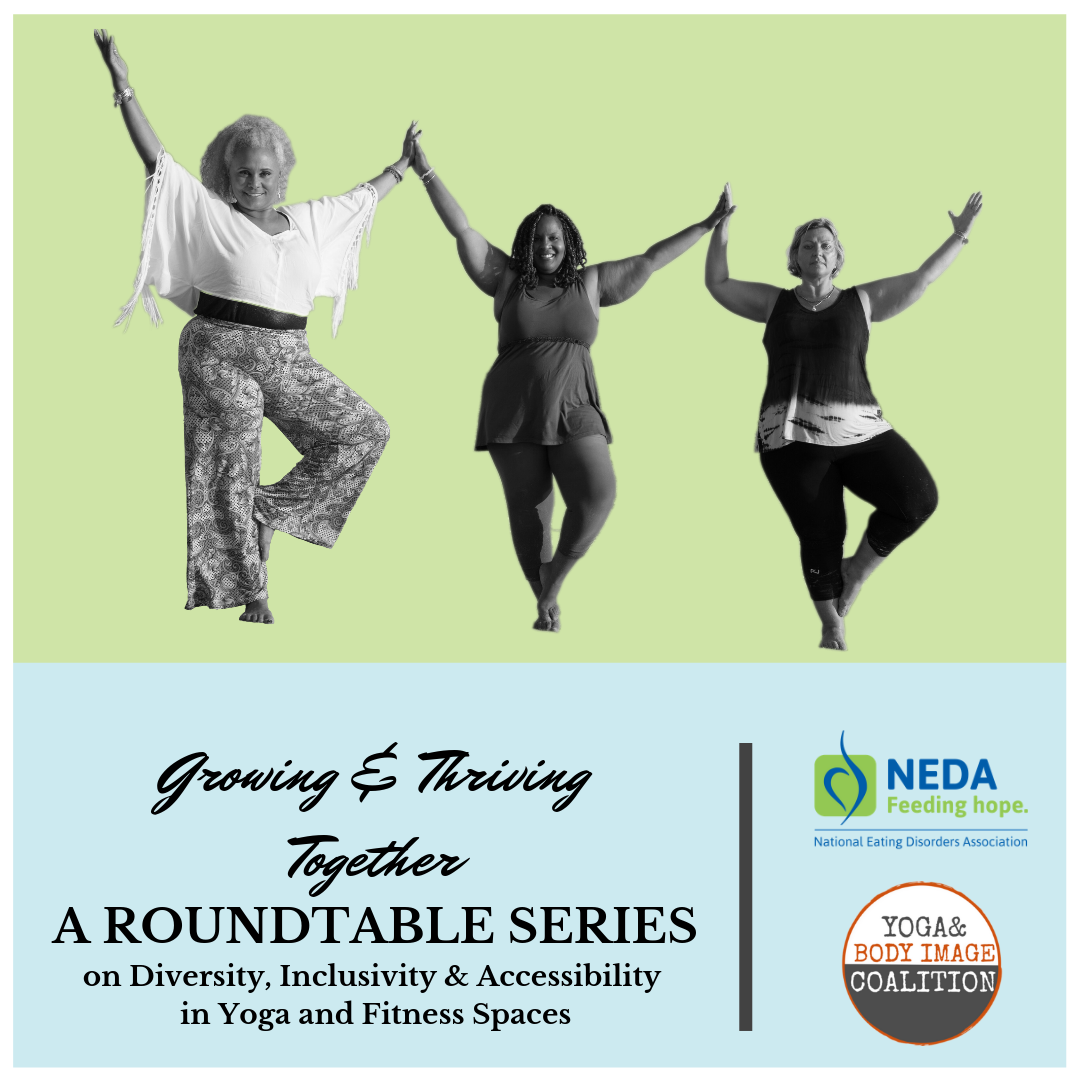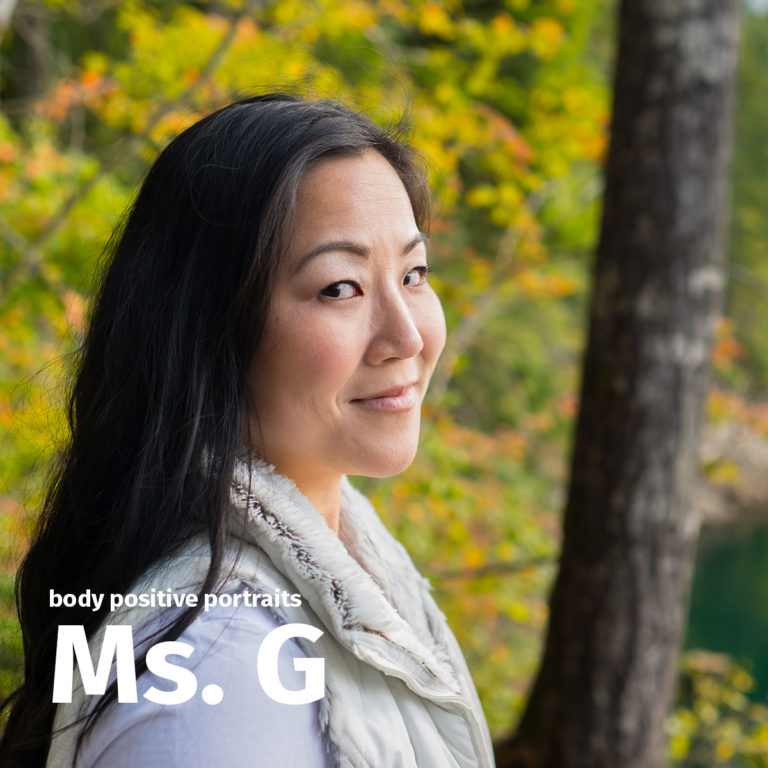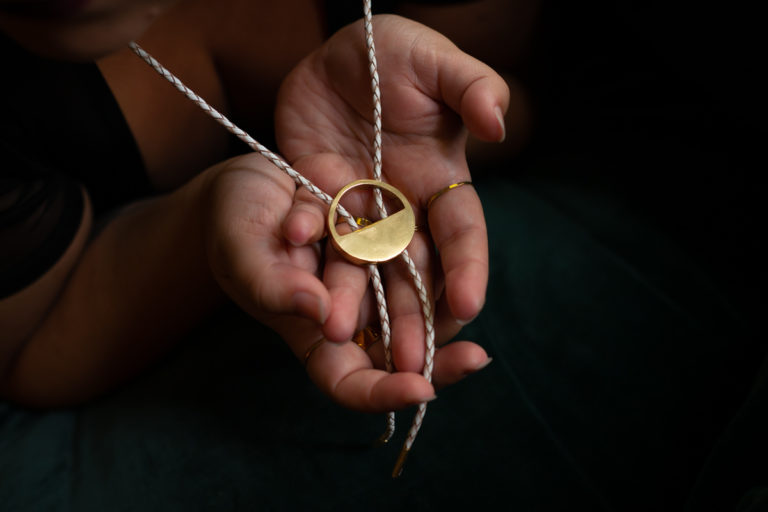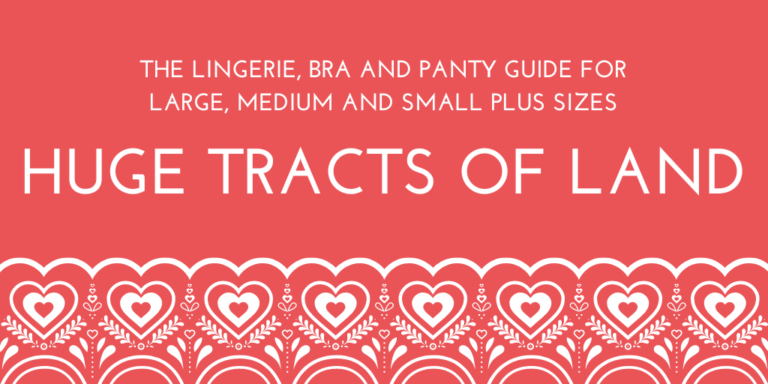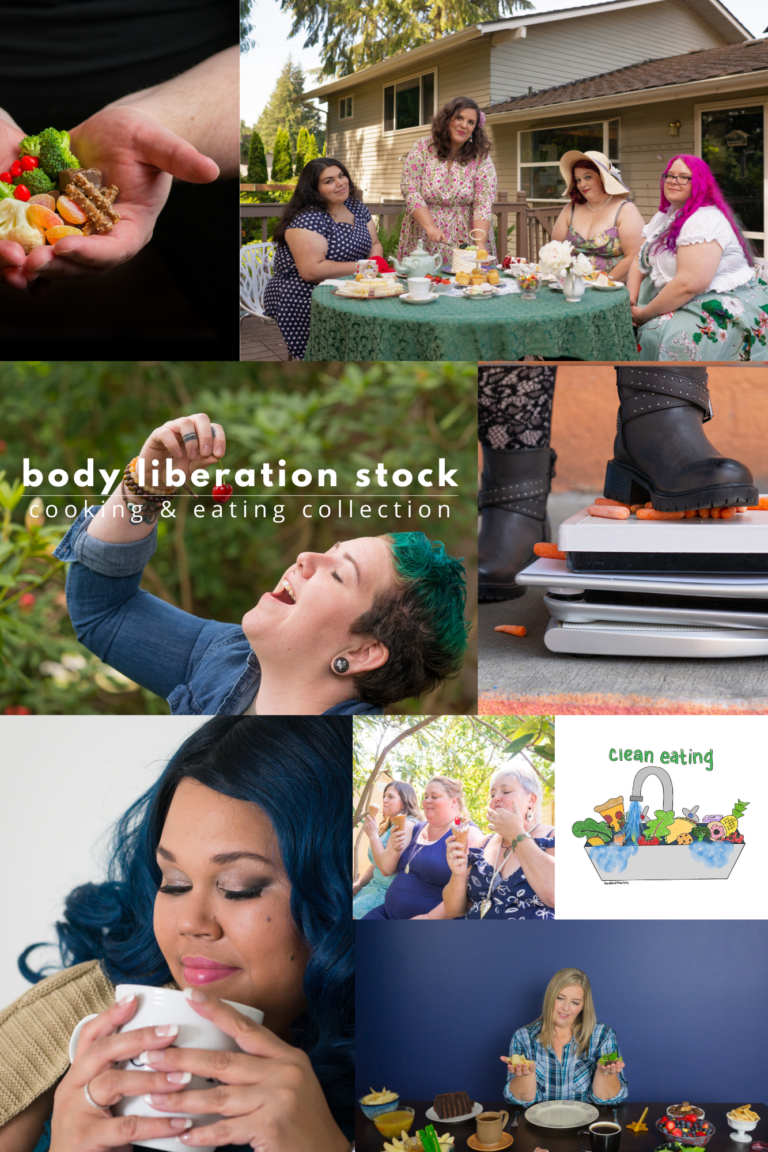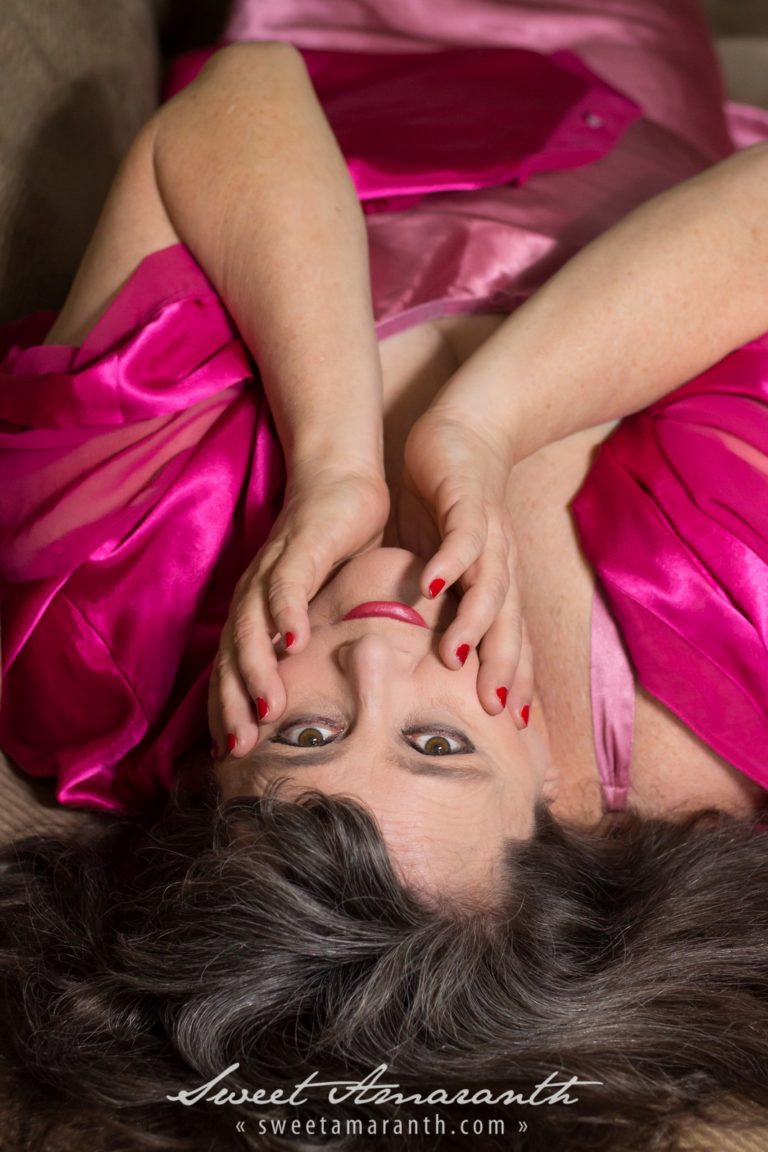Inclusive and Diverse Marketing in Yoga & Fitness Spaces: A NEDA and YBIC Roundtable Discussion (video with transcript)
I was honored to recently be part of a roundtable series, a collaboration between the National Eating Disorders Association (NEDA) and Yoga & Body Image Coalition (YBIC), called Growing & Thriving Together: A Roundtable Series on Diversity, Inclusivity & Accessibility in Yoga and Fitness Spaces.
The discussion for which I was a panelist focused on addressing the importance of inclusive and diverse marketing in yoga and fitness spaces. As someone with a marketing background who produces stock photos (often fitness- and yoga-themed) of people with large bodies and who also has a deep belief and investment in inclusive frameworks, this was an amazing panel to be part of.
Here’s our complete conversation. You can watch the video above and/or follow along with the transcript below.
Kerry O’Grady: Hi, everyone. Thanks for joining today’s roundtable discussion focused on inclusive and diverse marketing in fitness spaces. I’m Kerry O’Grady. I’m at National Wellness Liaison. And I’m incredibly honored to be moderating today’s conversation with these incredible women brought to life by NEDA and the Yoga & Body Image Coalition.
So, I want to kick off by introducing our panelists. So, I’m just going to turn it over to them. And Lindley, let’s start with you!
Lindley Ashline: Hey! My name is Lindley Ashline. And I am a body acceptance photographer outside of Seattle, Washington. I focus entirely on bodies that don’t get represented in mainstream media and mainstream photography. So, that is primarily people who identify as plus size or fat, people of color, and the LGBT+ community.
So, I do photography sessions with clients at BodyLiberationPhotos.com, stock photos (which I’m sure we’ll be talking more about) at RepresentationMatters.me. And because I like to do things, and I don’t like to sleep, I also run a body positive subscription box called the Body Love Box.
Kerry O’Grady: Amazing! Thank you so much. And then, we have Pia.
Pia Schiavo-Campo: Hi guys! It’s Pia Schiavo-Campo. I am the author of the blog, Chronicles of a Mixed Fat Chick, where I have been writing for about nine years about body positivity, about body image, how that intersects with different parts of our identities such as gender and race.
And I am also a public speaker and a certified coach. And so, a lot of my platform is about lifting up marginalized voices. And we are working towards making sure that folks who are queer, folks who are of color, who might be differently abled are being represented in the media in really positive ways; and also trying to change the notions of what beauty is in our society.
I’m recently also the co-author of a book of affirmations that you can find on Amazon. And it is called Love It! 234 Inspirations & Activities to Help You Love Your Body.
Kerry O’Grady: Love it! Thank you both so much for joining us for this important conversation. So let’s get into the meat of things, shall we?
So, let’s start this conversation by talking about marketing and recruiting in relation to the body confidence movement because I think we’re all in agreement that they’re not quite aligned in today’s marketplace.
What do you think marketers and recruiters need to know about inclusivity and diversity today? And how should they implement it into their yoga and fitness spaces?
Pia Schiavo-Campo: Yeah! So, I think part of it in terms of the way that things are being marketed, I think it’s super important, number one, to have bodies that are larger. It’s important to have bodies that clearly show that they have different abilities—and showing folks of color. I think that’s really important because we’ve so not been a part of that space. We haven’t been invited into that space.
And I think the other piece is also making sure that folks represent yoga not as this competitive thing, but as something that is an individual journey to sort of be present in your body. So, I think those are really important.
Kerry O’Grady: Oh, absolutely! Lindley, what do you think?
Lindley Ashline: I want to bring in some wisdom from an author named Emily Nagoski. Nagoski is the author of two books, Come As You Are and Burnout. And Come As You Are is an absolutely transformative book. And in it, Emily talks quite a bit about body image and how it affects particularly us women, but body image and how it affects people’s self-image and sex lives and so on.
But she says: “Images matter. They tell us what’s possible, what things go together, what belongs and doesn’t belong. And we’re all just trying to belong somewhere.”
And I feel like that is so important here because, as marketers, we need to show people that they belong in our businesses. They belong in our spaces, whether their spaces are online or physical. And of course, yoga can be either or both. And it’s just so incredibly important that we show images of who belongs because it’s usually silly to say, “Well, I never see any people who might identify as fat in my local yoga studio websites. I never see them in the videos. I never see them in the social media promotion. And so, as a fat person, I might not be welcome.”
It sounds very reductionist to say it that way. But that’s how we, as humans, operate. We internalize what we see. We internalize this is the kind of body that does yoga. This is the kind of body that is welcome not just in the yoga world, but in this particular studio.
And so, as marketers, when we say, “Here’s who belongs,” that’s who we’re going to attract.
Kerry O’Grady: I love how you just brought up the word belonging because I feel like, in this space, the word belonging to a lot of studio owners and instructors just means having bodies in your class. And so, if you end up in a class, then you’re officially engaged in belonging.
What can instructors do or studio owners do in order to make that belonging feel authentic?
Pia Schiavo-Campo: I think that’s such a great question. I want to just sort of call back the first time that I went to a yoga class which was 20 years ago. And I remember being in this space where I was the only person of color, certainly the only person of size, and thinking to myself, “I don’t know if I belong here.”
And as I’m trying to do these poses, number one, I don’t even know what yoga is about really. There has been no information or introduction to help me understand what am I supposed to be doing, am I supposed to be in competition with others.
And I remember the first time that I did yoga, I farted very loudly in this room full of people. And I was mortified! And I’m not kidding. That was literally the last time that I did yoga for so many years. I didn’t come back to it until maybe 2014 when I started to see more visibly fat people and people of color doing yoga.
And I actually found a great place near me in south LA with a teacher who was in her 70’s, a woman of color. And being in that space with other women who were my size or larger, women of different ages and abilities, and seeing the way in which she—her approach was very much, “If something doesn’t feel good to your body, don’t do it.” That was number one. She went out of her way to make sure that she made those adjustments for you based on what your body could do.
And it was never from a shaming point of view. It was very much about, “This is about you. This is about your body.” And she just made me and others feel visible and that we were really able to do this. She took away that sense of competitiveness that I think yoga is often marketed as, that if you can’t do a handstand, you’re not doing yoga… which I think is problematic.
So, those kinds of experiences, of making sure that you don’t call people out individually, but that you’re really sort of offering these alternate ways to everybody in the room and not singling folks out.
Kerry O’Grady: I love that. That story is so powerful too for so many reasons… including the little embarrassing moment. That is not even really embarrassing. It’s just human,
Pia Schiavo-Campo: Totally! Still mortifying!
Lindley Ashline: I’ve done it! Our bodies are going to do what they want to do.
And I feel like it’s not just modifications in class. But there are things that can be done in yoga spaces, in fitness spaces, in all kinds of spaces that are related to physical activity. There are things we can do through the entire customer lifecycle, customer experience, to bring in diversity, to bring in who’s belonging, to bring in who’s welcomed, and to make all kinds of bodies welcome and accommodated in a space.
And I’m not crazy about using the word accommodated because it makes it sound like it’s special, like it’s an extra measure. And so, I need a better word for that because we should be accommodating—you see, there it is again—all kinds of bodies as our default. It shouldn’t be, “Oh, well… you know, maybe I should consider getting some props for my yoga studio as an extra measure.” That should be your default.
But there are things that we can do through that entire customer lifecycle starting with who’s appearing on your social media, what kind of images are on your website because those are the people that not only are you asserting that “these are the people that we expect to see in our spaces, that we welcome by default into our spaces,” but it’s also who was going to be physically accommodated and adjusted for, who is going to be here when I walk in, what am I going to see.
If what is on your website and what is on your social media isn’t representative, then you’re losing all those people both from a pure business standpoint—those are customers who aren’t coming in because, if I don’t see any fat people on your website, if I don’t see any fat people in your social media, I’m going to assume that when I walk in, I’m going to be the only fat person. And that may not be accurate. But how would I know?
So, it’s looking at your business strategy and your business operations from end-to-end, not just modifications in the studio (although that’s really, really, really important) and not just your social media, but actually walking through “How am I interacting with potential customers? How am I interacting with my actual customers?” all the way through that life cycle.
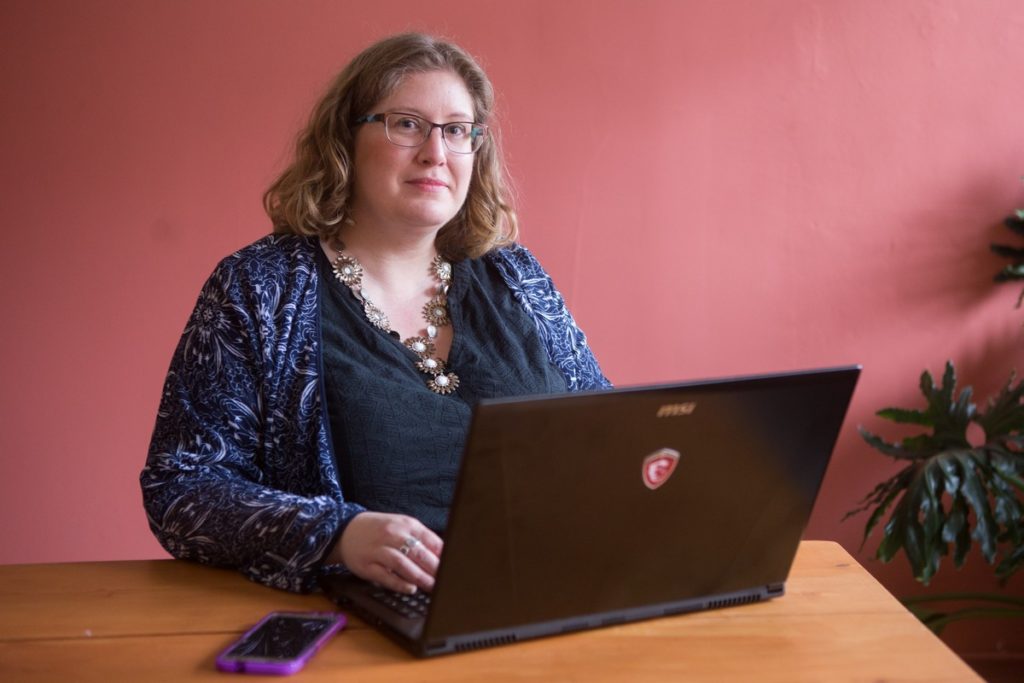
Let’s dig deep. Every Monday, I send out my Body Liberation Guide, a thoughtful email jam-packed with resources for changing the way you see your own body and the bodies you see around you. And it’s free. Let’s change the world together.
Kerry O’Grady: I love that you just use the word modification because you were just talking about accommodations. And I think modification is actually a perfect word for what you are trying to accompany.
And I think both of you bring up such great points about modifications and it being not just something that’s special, but something that’s just part of the experience. What recommendations would you make to the fitness and studio owners and yoga owners that are watching right now when it comes to the space and the class to make everybody feel included?
Pia Schiavo-Campo: Yeah, I think part of it is really making sure that you’re welcoming everybody in the same way. I think that particularly if it’s a beginner class, to really sort of have a conversation at the very beginning. If someone is a newcomer to yoga or just a newcomer to your class, to really practice being in that space by explaining what the purpose of yoga is.
I think that, a lot of times, when I’ve seen classes or been to classes, oftentimes, if you’re new, someone might acknowledge you, someone might not. And you just kind of dive in. And I think it’s really important to just set the tone for that space. So, whether it’s just taking a moment to ask people to just sit in their bodies to know that everybody is welcome there, the teacher being very explicit about saying, “Please let me know if there’s anything that you need. Raise your hand. If you need help with a modification, raise your hand,” and just really setting that positive tone I think is super, super important and make […]
Kerry O’Grady: I think we lost Pia’s sound for a second. I’m sure she’s saying so many important things.
Lindley, while we try to get Pia back. I was wondering if you have any advice or comments on that matter.
Oh! Pia, are you back?
Pia Schiavo-Campo: I’m back! I don’t know what happened. Sorry, guys!
Kerry O’Grady: We missed so many amazing things that you were saying.
Pia Schiavo-Campo: Technical issues, what are you going to do?
Kerry O’Grady: Rewind, yeah.
Pia Schiavo-Campo: Rewind!
Kerry O’Grady: So, I think we left off with making people feel welcomed through conversations and making sure that they feel comfortable with modifications.
Pia Schiavo-Campo: And I think it’s also really important for teachers to stress that this is not meant to be a competitive space, that this is really about your own journey. And I think that they need to be extremely explicit about reminding folks that, if you cannot do a pose, you don’t have to do it. It’s okay to just sit on your back. If you want to be in child’s pose, do what feels good for your body in the moment. I think that’s so, so important because people often feel shamed when they can’t do a headstand. Well, I can’t do a headstand. I may never be able to do a headstand, and that’s okay.
Let’s make the space and set the tone that this is an experience and this is something that everyone is welcome to do.
Kerry O’Grady: Absolutely love that!
Lindley Ashline: I actually want to talk about curb cuts for a second. And I promise this is relevant, it’ll lead right back in.
But at least here in the US with the Americans with Disabilities Act, we’re now used to seeing on city streets, there’s a curb cut so that you don’t have to step off the curb.
And when I was growing up, those were already relatively standard. So I’m about 40. So I’ve never lived in a world where that was just not a thing.
But my understanding is that there was some pushback at the time like, “Oh, this is such an accommodation. It’s an extra measure for just people who use wheelchairs” or whatever.
But what happened was, now that we have these curb cuts, everybody uses them—people who’ve broken a leg, they may need those. People with strollers, people with shopping carts, people… just sometimes, it’s easier. Sometimes, people find that easier than stepping off the curb. And now, it’s such a part of our lives that we don’t think about it.
But the point is that, when we modify things so that they include more people, more bodies, it benefits everybody.
So, when you’re teaching a class, any kind of fitness class—it’s really easy to see yoga as an example, but this applies to anything. When you’re teaching a class, and you have modifications ready, and you are presenting them to everybody, not singling out the fat person because you assume they’re going to need a modification—because there are some fat folks who are extremely bendy and do not need modifications. I personally need a lot of them because I’m not very flexible). But I would probably be the same level of flexible if I were in a different body. So I would still need this modification.
And so, when you are presenting a range of modifications for a range of different mobility levels and flexibility levels and body shapes, you’re helping everybody because for all you know, some of the medium-sized people, or even some of the thin folks in your class, may need those modifications as well or find them useful.
And so, it’s not like you’re having to take extra measures just to serve a small portion of the population. I want to keep coming back to that because being inclusive, it benefits everybody. It’s not just a tiny, little population that you’re having to make a great deal of effort for. It’s everybody. Everybody finds those things useful.
Kerry O’Grady: That’s such a great point to make. Oh go, Pia, sorry…
Pia Schiavo-Campo: No, I just I love what Lindley just said. I just think it’s really powerful. And I just want to touch really quickly on the word inclusion because I think when we use the word inclusion—I am starting to sit with that word a lot lately and what it means.
To me, inclusion means that the table is already set, and yes, you can come to it. And I think what Lindley is saying, and what a lot of us are saying, is that we basically need to smash the table and start from scratch so that everybody is part of creating it.
Inclusivity suggests, “You can sit here, but you haven’t been part of the rule-making of creating this community.” So how do we start from scratch, so that you really are creating these equitable, safe spaces for everyone?
Kerry O’Grady: I love that!
Lindley Ashline: Absolutely!
Kerry O’Grady: And one point, and then I want to move to Sabrina because she just got here. We’re so excited to have you. Welcome!
Sabrina Strings: Thank you!
Kerry O’Grady: Having people who might be affected be part of that conversation is so incredibly important to be getting buy-in and loyalty with any class, not just fitness classes—Lindley, I love how you said that. Ask your customers what they want and how they would feel included and feel like they’re belonging. That is a way that you’re going to make people feel more comfortable with modifications if they’re part of the process. Love that!
Sabrina, welcome!
Sabrina Strings: Thank you!
Kerry O’Grady: I was hoping that you can maybe say just a few words about yourself. And then, we can jump into our next question and hear your thoughts.
Sabrina Strings: Absolutely! Well, good afternoon, everyone. And I apologize for being late. But I have my office hours today, and my students were coming on masse. It was a beautiful thing to see.
So, my name is Sabrina Strings. I am an Assistant Professor of Sociology at UC Irvine. And I’m also author of the book, Fearing the Black Body: The Racial Origins of Fat Phobia.
And in addition, I am a certified yoga instructor and one of the co-founding editors of the Race & Yoga Journal.
Kerry O’Grady: Amazing! Thank you so much. So, if you don’t mind me starting with you with our next question, that would be amazing.
Sabrina Strings: Absolutely!
Kerry O’Grady: I wanted to just switch topics a little bit to buzzwords (although I feel like we’ve covered it a little bit in our last two questions).
Buzzwords, like let’s say “body positive” or “body positivity” or probably our favorite, “yoga for every body,” those clichés. I’m sure we can think of hundreds more. What are some of the dangers that you think happen when we’re throwing out phrases like this without images and outreach to back it up?
Sabrina Strings: Yeah, that’s an important one. I think people often hear body positivity, and what they think immediately is, “Okay, love your body.” And that’s true. That is definitely part of body positivity. It should involve loving your body.
But it should also involve a recognition of the fact that certain bodies, certain people, certain communities are being stigmatized based simply on their appearance.
So, when we talk about body positivity, it’s not enough for someone who largely fits within the mainstream to say that and maybe even mean it about their own bodies. What we really have to do is think about who are the people who have been excluded from these conversations, what types of bodies are outside the specter of often even being given consideration, and how can we actually put them in a position of being able to speak about their exact experiences and the types of things that they would like to see change in order to feel welcome.
Kerry O’Grady: That’s a great point, a strong point to start off with. Pia or Lindley, do you have anything to add?
Lindley Ashline: [cross-talking]
Pia Schiavo-Campo: [cross-talking]
No, go for it! Go for it.
Lindley Ashline: Alright! So, I want to jump in on that from a purely marketing standpoint as someone who occasionally practices yoga, but who’s more focused on this from the marketing side. I want to jump in with these buzzwords—body positive, yoga for every body.
We want to put those on our website. We want to use those on our social media. We want to use those hashtags. And there is nothing wrong with that because even if we want to move maybe beyond body positive into something a little more radical, these are the terms that people are using to find us. And so, we need to be able to use those words.
But again, from a purely customer acquisition standpoint, if we want to actually acquire customers in bodies that have not traditionally been represented, it’s more than just using hashtags. Say I’m searching for a yoga studio in my area. And I’m searching for “Renton, Washington body positive yoga” or “Seattle, Washington body positive yoga,” and I see a whole bunch of studios pop up that have body positive or every body in their titles, but then I still don’t see any fat people in the website, or people of color, or whatever, people with visible disabilities, and I still don’t see any of that on your social media, and maybe I’m looking through your website, and I’ve looked through every page, I don’t see anything about modifications, I don’t see anything about teachers training in accessible yoga, I don’t see anything about teachers who are larger bodies themselves, that’s when you have a customer disconnect.
And so, you can use all those right buzzwords, but if you’re not backing it up with action and getting that training and getting the ability to offer these things, you’re still going to lose people. And then, it kind of makes you look like a hypocrite too.
So, it’s not just… you know, you got to back it up.

Let’s dig deep. Every Monday, I send out my Body Liberation Guide, a thoughtful email jam-packed with resources for changing the way you see your own body and the bodies you see around you. And it’s free. Let’s change the world together.
Pia Schiavo-Campo: Absolutely! Yeah. You know, those buzzwords, I feel like, maybe 10 years ago, when I think this movement was really kind of bubbling up, and it was feeling very grassroots, I think that that word was a word that a lot of fat folks, in particular, were using to sort of like reclaim their bodies as being valid. I think, now, we see marketers who have co-opted that, and they’re using that to sell things, right?
But again, as Lindley said, we’re not necessarily seeing that representation. So there’s no alignment.
I mean to me, I think of body positivity as this sort of grassroots movement that was originally about being seen, about being heard, about having equitable access to resources and representation across the board. And I think we’re making small steps towards that. But I still think that—
Another piece that I heard someone say was that, you know, body positivity is about loving yourself. And while I think we all strive for that, I think there can even be this notion of getting caught up in the fact that you have to love yourself every day or in every moment of the day, and you don’t, that this is really about a process. It’s not about arriving at some place, but about sort of finding and accepting where we are in the moment and that you can be body positive and be unhappy with your appearance. You can be body positive and still be striving to achieve something specific around your body.
And so, I think it’s just important that when we’re using that word, that we’re really clear and explicit about how we’re using it because I don’t think everyone who’s using it really knows what it means, or we don’t have this sort of standard definition about what it is. Everyone has their own… which is very confusing for people.
Kerry O’Grady: Yeah, I completely agree. That brings up another really great point about body positivity when it comes to the instructor and how they use it. They’re supposed to be the instructor of a yoga class or any fitness class—this can apply to any fitness class. They’re supposed to be the pillar of body positivity. And they relay body positivity, whether they’re trained to do so, or they want to do so. But a lot of the time, they have confidence issues themselves. And they’re teaching a class full of people to try and promote that onto them.
What do you think of the dangers of fitness instructors who may not be in touch with what body positivity means to them? And how can that rub off the wrong way on the people in their classes?
Lindley Ashline: [cross-talking]
Sabrina Strings: [cross-talking]
Kerry O’Grady: Lindley, let’s start with you first!
Pia Schiavo-Campo: Yeah, I see this happening all the time where people don’t realize that they are body shaming others or even themselves just in the course of conversation, whether it’s looking in the mirror and saying, “Oh, this is a skinny mirror” as though that somehow makes them feel better at the moment.
But when I’ve seen yoga instructors really focus on specific body parts, and using yoga as a means to create a specific shape, or let’s get those ripped abs, it becomes more about the appearance and less about building strength in the body.
So, for me, it really needs to be less about what does my body look like when I’m doing this pose, less about how will my body look after doing five weeks of yoga, and being focused much more on what are the physical benefits and what are the mental and emotional benefits of doing this.
And I think that’s one way to be way more body positive. But I’d love to hear from others as well.
Lindley Ashline: I think, for me, it comes back down to coherence. Again, I have this experience on a white, fat body. But if I come into your yoga class because you’ve said your body positive, but I come in and you don’t have a range of modifications for me—or any fitness space, if you say you’re a body positive gym, and I come in and I have some muscle issues in my arms (this is, again, my personal experience), if I come in with a weightlifting goal, you’re going to need to be able to accommodate that without hesitating or without giving me helpful suggestions on cardio that I didn’t ask for, or without making any reference to my body fats because that’s not what I’m there about.
But if you don’t have the modifications that are ready for me, again, out of the lack of coherence, people can tell that you’re not backing it up. And so you’ve got to be ready. You can’t say one thing, and then provide another.
And people can tell. We can tell when you said body positive and what you actually meant was positive about normative bodies, “I just haven’t really thought about the rest of the spectrum of bodies that exist.” We can tell.
Kerry O’Grady: That’s a great point.
Sabrina Strings: So, as a person who is thin and black, what I constantly experience when I go into yoga studios is a combination of anti-blackness and thin privilege. And so, the way that often plays out is that people see me, and in the moment, they’re like afraid because here’s this dark-skinned, black woman walking into their yoga studio, what is she doing it there, but then they think, “Oh, well, she has the kind of figure that we expect to see in a yoga personality.” And so then there’s sometimes this kind of relaxation that takes over.
I remember being in yoga training. And it was very interesting because people rarely wanted to have their mats next to mine—it’s not because they’re anti-black, it’s just whatever, something else that they can’t articulate. But then there were always these types of questions that I was getting that were so peculiar and absolutely unnecessary about how is it that you have Michelle Obama’s arms, how can I actually build my arms up to get them to look like you’re arms? I’m like, “You’re not going to be able to do that because this is just how my body looks. And this is how my genetic structure has dictated that I might appear.” It’s not because of yoga that I look like this.
And so, I think it’s so difficult because part of what is driving people to yoga right now is that there is this intense connection between yoga and fitness. And we think about like fitness in America, often, it’s like whiteness that comes up. And so, people are expecting to go to a yoga studio, and not just to see, but to become that white women.
So, to the extent that you exist in a body that does not meet those standards, you are going to find yourself constantly accosted, either because of race or because of your body type; or if you happen to live in a body that is fat and black, you’re going to experience even additional complications and discomforts.
And the one thing I want to say about this is that I’ve been in yoga trainings where people have said things about obesity, “Oh, obesity, so-and-so was obese, and we didn’t even know. How are we going to help them?” And I’m sure that this is a person who imagined that they were offering yoga for therapeutic purposes and that they were being body positive. But in reality, there’s oftentimes this attempt to tame, control and discipline that people don’t even reflect on, but that is nevertheless making its way into yoga studios constantly and becomes part of mainstream understandings of what yoga is… and it’s deeply troubling.
Kerry O’Grady: Such a powerful thing! All three of you said incredibly powerful things. But the theme that ran across was about assumptions and privilege. And I think that that’s such a great takeaway point from this question, is that yoga instructors, studio owners, any fitness professional needs to be aware of their own biases as well as their own assumptions about people to be able to change their perceptions. They have to be more aware. And I think that that’s a great takeaway point for anybody watching to help start being a little bit more reflective.
I love how you use that word, Sabrina, being more reflective because that’s only going to better you and make you more equipped to be more inclusive and diverse in a studio for sure.
Sabrina Strings: Yes, absolutely.
Kerry O’Grady: So, speaking of social, we talked about social media a little bit. I’d like to move to social media for a little bit of time.
How does social media play a role in diverse and inclusive marketing and advertising outside of what we’ve said before about just having the images (although images are worth a thousand words)?
But I also think that we brought up this great point about the images not really being the whole picture of what diverse and inclusive marketing and advertising is.
So, what do we think about social media practices today? And how can we help people improve at their locations?
Lindley Ashline: From a personal wish list standpoint (again, as someone who is going to be attending yoga classes as opposed to teaching them), I would love to see more yoga studios and teachers that are talking on social media, not just advertisements—again, beyond the images that you’re showing—about how you’re working with various types of bodies beyond than white ones, that also isn’t tokenizing or objectifying. And that is a really hard balance to strike.
I’m not suggesting that you say, “Oh, well, the other day in class, I had someone who was black and I treated them just like I treat everybody else.” Whoa! So, I’m caveating this very careful because I don’t want you to start using your existing students and clients and practitioners as fodder for your social media unless they have volunteered.
And even then, obviously, please don’t do it like that.
But I want to see how you’re interacting in the real world. I want to see, with consent, put up clips of your classes—again, with content of everybody who’s in the images or in the videos. But put up clips of your classes. Talk about the modifications you do.
And that’s harder. It’s harder. It takes more time than just putting up advertising for your studio, or just images of yourself practicing or whatever. Talk about that stuff. Bring it on head-on because any evidence that I have that you are even thinking about bodies other than normative ones is really cool.
Social media is both prescriptive and descriptive. We reflect what we see in our professional world around us. And what we expect to see on social media, that’s what we put up because we want to stand out enough to get customers but not so much that we scare people away. But it’s also prescriptive in that what you’re posting in your account right now becomes part of the overall feel. It becomes part of “this is the type of thing that we see on yoga or fitness social media accounts.” As such, you are also creating a culture even as you’re also trying to fit into it.
And so, the more that I see that you are doing the thinking and breaking out of that as a potential customer, the more impressed I’m going to be.
Sabrina Strings: You know, I think that there’s so many amazing social media examples. So, we have Jessamyn Stanley. And obviously, we all know Dianne Bondi (she’s a part of this series). And so, there are many women out there who are modeling for us what it means to be outside of the yoga norm, but nevertheless, strong, visible yoga practitioners. And those sites are important.
And there are other body positive sites now going to positivity, this notion that it’s important to spotlight people who do not represent the American mainstream of beauty, but are nevertheless strong and dedicated to the practice. These people are out there, and they’re doing the work. And you simply have to find them.
But I also want to speak to what Lindley was mentioning, the whole problem of various companies using what I want to call diversity brochuring or diversity photoshopping in which they’re just taking images that they’ve seen of people, and they were like, “Look, we have a black. And look, we also have a fat person.” That is definitely problem.
And I think that you can recognize when people are simply using diversity brochuring because when they’re describing the kinds of offerings that they have, the offerings look just like any other studio. The offerings are not in any way specific to different types of people from various communities, different types of bodies, different types of physical limitations and abilities. It’s like vinyasa, right?
And so, I think that when we are savvy, we can recognize that a person is simply trying to Photoshop in a little bit of diversity to get some more of that sweet, sweet coin. But if we are truly interested, there are those websites and there are those people we can find who are really doing the work in a meaningful way.
Pia Schiavo-Campo: Yeah, I completely agree. I think it’s important not to tokenize, as I’ve heard both of you all say. And I think that people need to really ask the question: “Why do I want to even do this? Why do I want to be inclusive? Do I want to be inclusive because it’s about the coin? Or do I want to be inclusive because it’s the right thing to do?”
And frankly, I’m not sure everybody is in the space that’s ready to do that because that really requires you to look at yourself and to think about how you are upholding white supremacist ways of being in the world.
When you think about yoga spaces being white, I’m like yoga is not from white people. Yoga is from brown people from India. And yet when I go to a yoga class, I’ve never had an Indian instructor or ever even seen Indian people in my class.
I mean there’s a great article about this that I can post to the page later. But it’s just like this sense of “This is ours, and we’re letting you into the space,” it’s going back to that idea of inclusivity.
And so, I would suggest that if people really have a genuine interest in creating spaces that are for everyone, then they need to do their research. We’ve already heard that people like Jessamyn Stanley and Dianne Bondi. See who else is out there and what they’re doing before you just sort of start to put random photos on your feed or talk about things without truly understanding them.
Lindley Ashline: Yeah, there are so many resources out there at this point for everybody to learn from. You don’t have to invent that wheel. Go support the people who are doing the work and have the courses and are doing the education. And of course, many of those people are in non-normative bodies as well. Go support them and learn from them. You have support. These things exist. You don’t have to invent them.
Kerry O’Grady: Absolutely! I think all of you made such incredible points. And I want to just go back to the hiring practices. All of you really touched upon that, about hiring people in these classes that are representative of all different types of bodies.
Now, speaking of brochuring—and I think we have time for one more question, and I would love to ask this one. Speaking of brochuring, there are lot of studios right now who are hiring instructors from all different types, but not executing them in the correct way when it comes to having them become more relatable, marketing them as much as other people who might be on their site.
What do you think about the hiring practices right now in the yoga and fitness space? And how can we do better? I’m just going to say we because it’s collective. But what should studio owners be looking for and be cognizant of when going out and finding instructors who are more representative?
Sabrina Strings: I don’t know that that’s actually a priority for many studios. And I think that it should be. And we would hope that they would care about such a thing. But oftentimes, what they’re looking at is: does the instructor have their own embedded following, such that once we offer this class by this instructor, they’re already going to have people who are going to show up?
And so, I definitely noticed that when I was in the Bay Area. The culture there was like yoga personalities, like “this person is well-known, and so we’re going to hire them.” And oftentimes, the question of “But are they creating a space that is brave, that is comfortable, that is welcoming?”, that is not a concern at all. Often, the concern is the bottom line. Are we going to get more bodies in this space?
And so, I think we have to push for a culture in which that is a concern. It’s not just getting people in there. It’s what is yoga actually fundamentally about. If it’s not just exercise, if it’s about building a good sense of who you are and good relationships with other human beings, then we want to be able to hire instructors who are from a variety of different backgrounds, different abilities, different sizes, that can actually create a space in which individuals from different background feel welcome.
Pia Schiavo-Campo: Yeah, I think those are such excellent points. And something just popped into my head, also just thinking about class, that yoga classes are often very expensive, and that if you really want to create that space, then think about offering prices that are lower, so that it really is an accessible thing.
I live in South LA. And so, this can be a desert for a lot of things, not just food. I’m lucky to have a great yoga space that is near me. But as this neighborhood is gentrified, I’ve seen the yoga prices jump up.
And so, you’re really creating this sense of exclusivity, that yoga is really only for a certain type of person. I think that’s extremely dangerous. And I think all of what Sabrina said is just so key. Am I inviting you here because I know you can bring the people in, or do I genuinely care about creating community? Do I care about creating change?
And if you don’t, then it’s just kind of like don’t show up to the space. There are the resources available. We heard that from Lindley. And be genuine. Be willing to learn. Be willing to say, “I don’t know.” Sit in that discomfort and invite people who do know to help lead that charge.
Kerry O’Grady: Right! And I think you just brought up such a great point too about maybe, if that’s your initiative that you just want people in—and I know Sabrina mentioned this as well. If you’re just concerned about bringing people in, then maybe fitness and yoga isn’t the place for you. Maybe you need to do that introspection.
Pia Schiavo-Campo: Exactly!
Lindley Ashline: And in addition, in addition to these points, as you’re hiring, on the ground, in real life, it’s pretty likely that random a fitness studio, a random yoga studio owner is not necessarily going to be able to fill their entire staff or the entire complement of people who are affiliated with that studio in using the space with people who are in non-normative bodies because the pool of your prospective hires is going to include a lot of thin, white folks because that is who has been centered in those spaces. And so, you’re going to hell out of this one. And there’s nothing wrong with that.
But when you’re hiring, you are the employer. Even if this person is part time, even if they’re contract, even if they are just renting a part of your studio for their classes, you’re the employer. You’re in a position of power. You have that authority to say that anyone who is affiliated with you, your studio, your group, whatever, is at least minimally educated in body acceptance and require that the people who are coming in be able to offer modifications.
Require that they not be body shaming. Require that they have this compliment of things that you have decided are important because you get to dictate that. You get to say that. You don’t have to say, “Oh… well, this person is really well-known in the area. But ooh… they’re kind of shame-y. But they’re really well-known.” You’re the one who gets to make those decisions, and you get to set the tone for your entire space.
And that is not only really cool because you have that power, but it’s also a big responsibility. Step up !
Kerry O’Grady: It’s also an exemplar. It’s not just setting these expectations or the tone, but you’re becoming an exemplar and part of the change. And we need more people like that, right?
Lindley Ashline: Yeah, it’s time! If you needed a sign, here it is.
Kerry O’Grady: This panel, this group of women is the huge sign that we need for change for sure.
Well, we are getting ready to wrap up. Are there any final thoughts that the three of you would like to share on any topic that we discussed today? Or any parting words?
Pia Schiavo-Campo: I’m just extremely grateful for the changes that we are seeing. When I think about how I’ve curated my social media feeds, and that I’ve had the pleasure and the honor of taking classes from fat, black women, it has been so empowering and so life-changing in terms of showing me what my body is capable of doing.
And so, the work, the courageous work, that they do to put themselves out there—and I know that they get a lot of negative feedback—is courageous. I’m loving seeing that more and more women are sort of stepping up into that role.
What I want people to take away is that it’s important for us to not look at bodies, particularly thin bodies, and say “they’re capable of this, and they’re healthy,” and that large bodies have many limitations and can’t do things. And that tends to be the thinking that we have.
And so, I would just encourage people, whether you are a yoga teacher or someone who practices yoga, don’t make the assumptions. You don’t know what people are capable of. You don’t know what their health history is. Be open to seeing not only what you can do, but also what others are capable of doing, because they could probably teach you a thing or two.
Lindley Ashline: And I think my final words would be if this is the first time that you have thought about this, or you already have had a studio or fitness space in motion and you’re ready to make a change, or you’re just at this point where you’re a little overwhelmed and you don’t even know how to get started, I would say the first thing to do is to spend some time listening.
Take your own social media accounts, whether those are your personal ones or your business ones or both, and fill them up with diverse bodies. Fill them up with people in large bodies and people of color and people in various levels of ability. Let’s not forget that in this conversation too. Fill up your feed with all different kinds of bodies because that will help normalize them in your own mind and help you start centering and prioritizing the people who have not previously had a role in your head. Spend some time listening.
And while you’re listening to these individual people who are out there doing the work and doing the education, find some more ways to support them if you can. If they have a Patreon, subscribe. If they have any way to support them, PayPal them some money because they’re out there doing this work, and they’re mostly not getting paid for it.
Don’t ever stop listening. But when you feel like you have a little more sense of what the voices out there are that aren’t like yours, then find the education and enroll. Get those modifications. Buy the books, do the thing. Do whatever training you need to be able to, with increasing levels of competence, say, “I can center and support and serve more bodies than only ones that look like my own.”
After that, you audit your business. And you say, “Okay, where are we falling down? What are we going to fix?” and then you start taking action. So there’s your 4-step plan.
Kerry O’Grady: Love it!
Sabrina Strings: Yeah, these are great. And I just wanted to contribute. I want to pick up on something that both Lindley and Pia said.
Lindley was speaking to something that we often refer to as beginner’s mind in contemplative practices. We have to keep in mind that, even if you are a yoga teacher, even if you are studio owner, you don’t know everything. Especially if you want to create a welcoming space, you need to keep an open mind and constantly re-evaluate what you think you know.
And one of the things that people often think they know is that having a yoga certification is enough… when it’s not. Far too often, the certification just tells people about how well you can either do or teach various poses. It doesn’t tell people about your understanding of various yoga sutras or the history of yoga or how yoga is practiced in different communities. And all of those things, you need to constantly keep learning. So that’s the first one.
And then, I think Pia said something powerful which was that, if yoga is really about building a sense of community, then worrying about the bottom line should not be the bottom line. You are probably not going to be able to make amends on trying to create a more inclusive yoga practice unless you’re simply diversity brochuring.
So, if you’re truly interested in creating a more inclusive practice, it’s going to require you to engage in some steps that are not necessarily going to be lucrative, especially not at the outset. But it’s nevertheless going to be in line with yoga principles.
Kerry O’Grady: Incredibly powerful notes to end on! Thank you all so much, Lindley, Pia, Sabrina. Thank you for your time and sharing your thoughts and knowledge with us this afternoon.
Additionally, a big thanks to NEDA and the Yoga & Body Image Coalition for bringing this important conversation to the forefront of our hearts and minds.
So, please tune in on Monday for the third NEDA and Yoga & Body Image Coalition discussion. And that one will be on maintaining recovery as a yoga and fitness instructor.
So, thank you again, ladies. This has been wonderful and my privilege to talk to you all.
Pia Schiavo-Campo: Thank you!
Sabrina Strings: Thank you so much for creating this space.
Lindley Ashline: Yes!
Kerry O’Grady: Thank you.

Let’s dig deep. Every Monday, I send out my Body Liberation Guide, a thoughtful email jam-packed with resources for changing the way you see your own body and the bodies you see around you. And it’s free. Let’s change the world together.
Hi there! I'm Lindley. I create artwork that celebrates the unique beauty of bodies that fall outside conventional "beauty" standards at Body Liberation Photography. I'm also the creator of Body Liberation Stock and the Body Love Shop, a curated central resource for body-friendly artwork and products. Find all my work here at bodyliberationphotos.com.

